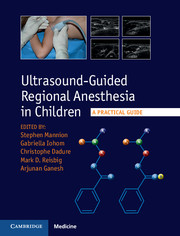Book contents
- Frontmatter
- Contents
- List of contributors
- 1 Introduction
- Section 1 Principles and practice
- Section 2 Upper limb
- Section 3 Lower limb
- Section 4 Truncal blocks
- 14 Ultrasound-guided ilioinguinal/iliohypogastric block
- 15 Ultrasound-guided transversus abdominis plane block
- 16 Ultrasound-guided rectus sheath block
- 17 Ultrasound-guided paravertebral block
- Section 5 Neuraxial blocks
- Section 6 Facial blocks
- Appendix: Muscle innervation, origin, insertion, and action
- Index
- References
17 - Ultrasound-guided paravertebral block
from Section 4 - Truncal blocks
Published online by Cambridge University Press: 05 September 2015
- Frontmatter
- Contents
- List of contributors
- 1 Introduction
- Section 1 Principles and practice
- Section 2 Upper limb
- Section 3 Lower limb
- Section 4 Truncal blocks
- 14 Ultrasound-guided ilioinguinal/iliohypogastric block
- 15 Ultrasound-guided transversus abdominis plane block
- 16 Ultrasound-guided rectus sheath block
- 17 Ultrasound-guided paravertebral block
- Section 5 Neuraxial blocks
- Section 6 Facial blocks
- Appendix: Muscle innervation, origin, insertion, and action
- Index
- References
Summary
Clinical use
The paravertebral block was first described in 1905 by Hugo Sellheim in an attempt to find an alternative to spinal anesthesia. This new approach, which targeted the spinal nerves at the emergence from the spinal column, was found to be safer than spinal anesthesia, having less adverse cardiovascular effects. However, the technique was largely abandoned until 1979, when Eason and Wyatt reintroduced the paravertebral block into modern-day regional anesthesia practice (Eason and Wyatt, 1979).
Paravertebral blocks can provide excellent post-operative analgesia in children for thoracic and abdominal procedures. Both unilateral single injection blocks (thoracoscopy, renal surgery, inguinal hernia) and bilateral single injection blocks (small umbilical hernia) have been described. While the efficacy of single injection blocks is limited (Hill et al., 2006), the insertion of a catheter can prolong post-operative analgesia up to several days (Boretsky et al., 2013). Unilateral continuous blocks are commonly performed for thoracoscopy, thoracotomy, rib resection, rib fractures, thoracoscopic aortopexy, patent ductus arteriosus ligation, abdominal wall mass excision, and renal surgery. Bilateral continuous blocks are also performed for laparotomy, bowel resection, Wilms tumor resection, pancreatectomy, and splenectomy (Visoiu and Yang, 2011; Ali and Akbar, 2013; Boretsky et al., 2013). Paravertebral blocks may have a role in the management of chronic pain in children.
Paravertebral blocks are associated with a high success rate, while placement of a thoracic epidural is often difficult and is associated with frequent failure (Chelly, 2012). Compared to thoracic epidurals, patients having paravertebral blocks experience less hypotension (especially if unilateral), no urinary retention, no motor weakness, and no opioid-related side effects; they also need less nursing resources and less monitoring (Pintaric et al., 2011). Serious complications related to epidurals, such as spinal haematoma and spinal cord injury, can be avoided. Paravertebral blocks (bilateral continuous) were successfully used in a mildly coagulopathic child, where the use of a thoracic epidural would have been strictly contraindicated (Visoiu and Yang, 2011). Advantages of ultrasound guidance over landmark-based and nerve stimulator techniques include: higher success rate, reduced local anesthetic (LA) volumes, and decreased time of block performance.
- Type
- Chapter
- Information
- Ultrasound-Guided Regional Anesthesia in ChildrenA Practical Guide, pp. 117 - 124Publisher: Cambridge University PressPrint publication year: 2015



